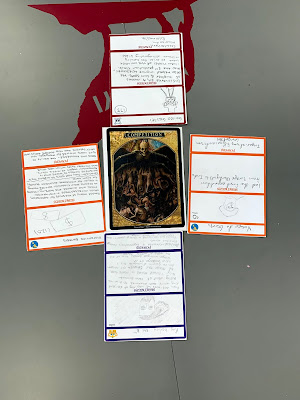This is an updated version of the project described here. We (me and Tara) have been working on iterating this project over several years and have gotten it to a pretty cool place this year.
 |
| Photo by Krists Luhaers on Unsplash |
The Manifesto Project is the final project our students do in grade 8. It is the culmination of year's worth of work, and combines everything students have learned about themselves and the world through their engagement with texts and ideas in English Language Arts throughout the year with everything they've learned about worldviews through the case studies we do in Social Studies that examines how different cultures shape their worldviews and what happens when worldviews come into contact and conflict with other worldviews.
The end goal of the Manifesto Project is to create a one-minute video manifesto that articulates the student's thoughts and ideas about what it means to be a human living a good and meaningful life.
Throughout the year, our students keep Commonplace Books. We gift each student a small notebook like this. We introduce these at the beginning of the year, and students add to them throughout the year as they come across good quotes and bits of wisdom in the things they read, listen to, and watch. More purposeful use of these Commonplace Books throughout the year is something that's on our list of things to work on this coming school year.
We begin our Manifesto project by "stuffing their Commonplace Books." Students spend some time on Slide 7 of our slidedeck in the choice board, watching some of the inspirational examples of manifestos and inspirational speeches and videos. As they do so, they add phrases and quotes from the inspiration to their Commonplace Book, making sure it's good and full of inspiration.
From there, they choose an essential question from a big list of good, deep questions, or write their own question, and find quotes and ideas in their Commonplace book that connect with the question. Then, they use a planning document to work through Pre-Production for their film: plan out their movie, create a storyboard, and write a script. We had different graphic organizers for the different kinds of manifestos that we included in our choice board.
We set a requirement that students needed to include two or three of the "Exhale" strands of Language Arts: writing, speaking, and representing. We might consider requiring them to include all three next year as those videos that didn't include speaking became a bit monotonous to view.
Then, students moved into Production. They got out there and record their footage, audio, and b-roll. After that, they began Post-Production, using software like iMovie or CapCut to put it all together. Some students opted to do animated videos, and for these students the Production phase and Post-Production phase sort of melded together into one. It was important for us to be flexible in each case as the methods and technologies used by each student were quite different.
The project ended with a big gala celebration where we rented out the local movie theatre to screen their films. We invited families to come and join us, had some popcorn, and enjoyed an hour and a half being blown away by the incredible wisdom of these 13-year-old philosophers. You can view the final movie here. Next year, we are going to have more students and will need to think about how we will adapt this so the final movie doesn't end up being too long - an hour and half was already pushing it. But celebrating the students in this way was really worth it and we will for sure find a solution to this problem.
A couple of things worth noting about this project: First, the assessment "checklist" we used that's a part of the student's assignment sheet worked really well. We signed off on each step as the students completed it, and students could move through this project at their own pace, though we did have internal mini deadlines when things should have been completed by.
Our students are very practiced and skilled in coming up with their own ideas through our Room to Breathe work, and the ideation part of this project was nothing new to them. For students who are less practiced at this, more scaffolding of that step may be needed.
Timing-wise, we loved being able to devote double blocks of class time in the month of June for this. Double periods (so around 100 minutes daily) were lovely to give them time to sink into this creative work.
We're happy to share the resources with you so you can try this project too, or hack it and make it your own.
- Slidedeck walking through every step of the process
- Assignment sheet and assessment checklist for students
- A variety of graphic organizers, depending on format: If You Do One Thing..., List, On _____, and Uncategorizable.






 Erin Quinn
Erin Quinn








